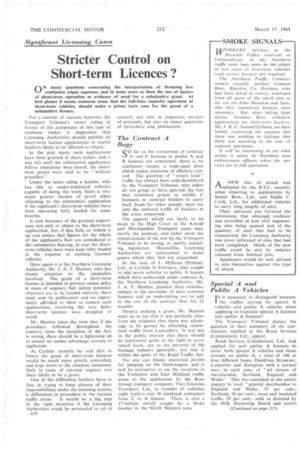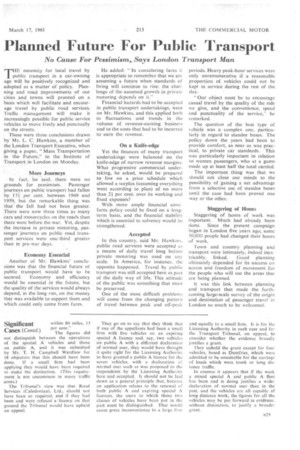Significant Licensing Cases
Page 60

Page 63

If you've noticed an error in this article please click here to report it so we can fix it.
Stricter Control on Short-term Licences ?
ON many questions concerning the interpretation of licensing Iwo confusion reigns supreme, and in none more so than the use of figures of short-term operation as evidence of need for a substantive grant. At first glance it seems common sense that the full-time capacity operation of short-term vehicles, should make a prima facie case for the grant of a substantive licence.
For a number of reasons, however, the Transport Tribunal's recent ruling in favour of the acceptance of this type of evidence makes it imperative that Licensing Authorities should publish all short-term licence applications to enable hauliers likely to be affected to object.
In the past many such, applications have been granted at short notice, and it
was left until the substantive application before objections were heard; the shortterm grants were said to be "without prejudice." Under the latest ruling a haulier, who has idle or under-employed vehicles capable of doing the work, faces a very much greater burden of proof when objecting to the substantive application if the applicant's short-term vehicles have been operating fully loaded for some months.
It now becomes of the greatest importance not only to object to the short-term application, but, if this fails, to follow it
up and ensure that figures for the whole of the applicant's fleet are considered at
the substantive hearing, in case the shortterm vehicles have been kept fully loaded at the expense of existing licensed vehicles.
Once again it is the Northern Licensing Authority, Mr. I. A. T. Hanlon, who has drawn attention to the • anomalies involved. The grant of a short-term licence is intended to prevent undue delay
in cases of urgency, but, unless potential
objectors are to be treated unfairly, there must now be publication and an oppor
tunity afforded to them to contest such applications, involving the very delay short-term licences were designed to avoid.
Mr. Hanlon takes the view that if the procedure followed throughout the country, since the inception of the Act, is wrong, there should be a tightening up to ensure no undue advantage accrues to applicants. At Carlisle recently he said that in future the grant of short-term licences
would be much more strictly controlled, and kept down to the absolute minimum. Only in cases of extreme urgency was there likely to be a grant.
One of the difficulties hauliers have to face in trying to keep abreast of their responsibilities under the licensing system, is differences in procedure in the various traffic areas. It would be a big step in the right direction if. the Licensing Authorities could be persuaded to act in B26 concert, not only in important matters of principle, but also on minor questions of procedure and publication.
The Contract A Bogy
0 far as the conversion of contract 13 A and C licences to public A and B licences are concerned, there is no confusion—simply a wide-open door which makes nonsense of effective control. The question of "return load" traffic has always been cold-shouldered by the Transport Tribunal, who either do not grasp, or have ignored, the fact that continual grants to enable C licensees or contract holders to carry back loads for other people, must eat into the outward traffic of hauliers in the areas concerned.
The appeals which are likely to be made to the High Court in the Arnold and Merchandise Transport cases may clarify the position, and either show the interpretation of the law by the Transport Tribunal to be wrong, or justify amending legislation. Meanwhile, Licensing Authorities are constrained to make grants which they feel are unjustified. In the case of J. Millican (Penton), Ltd., at Carlisle in February, who sought to add seven vehicles to public A licence which were authorized under contract A, the Northern Licensing Authority, Mr. J. A. T. Hanlon, granted three vehicles, subject to the surrender of their contract licences and an undertaking not to add to the rest of the contract fleet for 12 months.
Despite making a grant, Mr. Hanlon went on to say that it was perfectly clear from the evidence that there was advantage to be gained by obtaining returnload traffic from Lancashire. It was not in the public interest that there should be substantial gains in the right to carry return loads, nor in the interests of the haulage industry generally; nor was it within the spirit of the Road Traffic Act. No one can blame interested parties for jumping on the band-wagon, and it will be instructive to see the reactions in the Yorkshire and East Midland traffic areas to the application by the Ross Group transport company, Two Counties Transport, 'Ltd., to transfer 41 vehicles; eight trailers and 36 insulated containers from C to A licence. There is also a 17-vehicle switch sought by a Stoke haulier in the North Western area
Special A and Public A Vehicles
iS it necessary to distinguish between the traffics carried by special A
vehicles and public A vehicles when applying to translate special A licences into public A licences? The Transport Tribunal discuss . the question in their summary of the conclusions reached in the Road Services (Caledonian), Ltd., appeal.
Road Services (Caledonian), Ltd., had applied for new public A licences to cover both special A vehicles and those already on public A, a total of 106 at four different bases, Dumfries, Stranraer, Lockerbie and Abington, with a normal user, in each case, of "all classes of merchandise, Scotland, England and Wales." This was amended at the public inquiry to read, "general merchandise to England and Wales, 55 per cent.; Scotland, 10 per cent.; meat and insulated traffic, 20 per cent.; milk as directed by the Milk Marketing Board and smalls
within 80 miles, 15 per cent."
The figures did not distinguish between the operations of the .special A vehicles and those on public A, and it was submitted by Mr. T, I-I. Campbell Ward law for 18 objectors that this should have been done. If a small firm had been applying they would have been required to make the distinction. (This requirement is not uncommon in many traffic areas.) The Tribunal's view was that Road Services (Caledonian), Ltd., should not have been so required, and if they had been and were refused a licence on that ground the Tribunal would have upheld an appeal.
They go on to say that they think that if one of the appellants had been a small firm with five vehicles on an expiring special A licence and, say, two vehicles on public A with a different declaration of normal user, they would have thought it quite right for the Licensing Authority to have granted a public A licence for the seven vehicles, with a declaration of normal user such as was proposed to the respondents by the Licensing Authority here and accepted. It should not be laid down as a general principle that, because an application relates to the renewal of both public A and expiring special A licences, the users to which those two classes of vehicles have been put in the past must be distinguished. That would cause great inconvenience to a large firm
and equally to a small firm.. It is for the Licensing Authority in each case and for the Transport Tribunal, on appeal, to consider whether the evidence broadly justifies a grant.
They upheld the grant except for four vehicles, based at Dumfries, which were admitted to be unsuitable for the carriage of loads which were trunk or long distance traffic.
In essence it appears that if the work a mixed special A and public A fleet has been and is doing justifies a wider declaration of normal user than in the past, and the vehicles are all capable of long distance work, the figures for all the vehicles may be put forward in evidence. without distinction, to justify a broader grant.




































































































































